Microscopic Experiments to Assess the Macroscopic Sweep Characteristics of Carbon Dioxide Flooding
Abstract
:1. Introduction
2. Research Methods
2.1. Geological Characteristics of the Study Area
2.2. Experimental Devices and Samples
2.3. Experimental Methods
- (1)
- A model with specific pore structures and channels was created on a transparent glass plate using a hydrofluoric acid solution to simulate a real micro-pore network.
- (2)
- Simulation oil (a viscous liquid with dye mark) and simulation water (an aqueous solution with dye mark) were prepared according to the specific experimental conditions to be simulated.
- (3)
- The model was placed under a microscope or transparent observation equipment and connected to a fluid injection system to conduct different driving experiments, such as water flooding, carbon dioxide non-miscible flooding, and carbon dioxide miscible flooding, to simulate various extraction processes.
- (4)
- Using a microscopic visualization system, the initiation characteristics and dynamic evolution of residual oil in the blind-end pore space were observed and recorded through a microscope or a high-resolution camera under different alternation modes [17].
- (1)
- All experimental equipment, including the injection pump, nitrogen cylinder, pressurization device, fluid intermediate container (containing N2 + CO2 mixture, formation water, crude oil), gas mass flow meter, and steam generator, were checked. The two-dimensional scaled physical model was prepared to simulate the environment of the underground reservoir.
- (2)
- The 2D visualized physical model was vacuumed and then saturated with simulated oil and placed at a constant temperature of 20 °C for 2 h to ensure full saturation. The vacuum pressure was 0.
- (3)
- Simulated formation water was injected at a rate of 50 μL/min until no further flow occurred in the 2D physical model.
- (4)
- During the experiment, parameters such as pressure, temperature, and flow rate were monitored and recorded, and the flow and ripple characteristics of the fluid in the porous medium were observed by the visualization equipment.
- (5)
- After the completion of the experiment, the collected data were analyzed to evaluate the macroscopic progression and coverage (wave and reach) of carbon dioxide in porous media and its impact on the displacement of oil and the change in the oil–gas interface [18]. In this context, “wave” refers to the movement of the injected carbon dioxide as it advances through the reservoir, forming a front that displaces the oil. “Reach” describes how far this wave extends and how effectively it sweeps through the reservoir, displacing oil from the rock matrix. Evaluating these characteristics helps to understand the efficiency of the recovery process and the extent to which the injected carbon dioxide can displace oil from the reservoir.
2.4. Experimental Scheme
2.4.1. Core Model Preparation
2.4.2. Micro-Model Preparation
2.4.3. Glass Etching Object Modeling
2.4.4. Two-Dimensional Visual Large-Object Model Setup
2.4.5. Two-Dimensional Visual Physical Simulation Experiments
3. Experimental Results
3.1. Microscopic Sweep Characteristics of Carbon Dioxide Flooding
3.2. Macroscopical Sweep Characteristics of Carbon Dioxide Flooding
4. Conclusions
- (1)
- Carbon dioxide flooding in non-homogeneous reservoirs: The target block reservoirs exhibit non-homogeneous stratigraphic characteristics. Two-dimensional visual experiments were conducted based on a glass etched object model to investigate the microscopic waves and characteristics of CO2 flooding. During water flooding, water is predominantly found in the large pore throats and pores connected to large pore throats, while the small pore throats and pore spaces controlled by small pore throats, as well as pore blind ends, are difficult to drain, leaving residual oil primarily in the form of small pore channel retention and adsorption on the wall surface. CO2 flooding is primarily a mixed-phase driving with crude oil, characterized by strong component exchange and pore filling. At the late stage of the driving, the oil film on the wall surface can be desorbed. The microscopic driving efficiency approaches 100%, and with an increasing CO2 pore volume multiplier, the crude oil in the pore blind ends can be cleanly displaced. Supercritical CO2 enters the blind-end pore space through component exchange and mass transfer, mobilizing a large amount of residual oil.
- (2)
- Macroscopic waves and characteristics of CO2 flooding: Three groups of two-dimensional visual physical simulation experiments were designed based on the distribution position of the isolation layer and the physical properties of T12 and T13. For the isolation layer located at the injection and production ends, combined injection–production and split injection-production methods were used to simulate the conditions. Under the strong non-homogeneity of the Lunnan 2 TI reservoir, different injection and production modes lead to noticeable differences in the mixed-phase wave characteristics and displacement effects between the two layers with permeability gradient differences. These differences directly impact the utilization of reservoir suction capacity, gravitational anisotropy, density differences, and the control effect of the isolation layer. The differences in the development effects of various injection and production modes are more closely related to the control effect of the isolation layer.
Author Contributions
Funding
Institutional Review Board Statement
Informed Consent Statement
Data Availability Statement
Acknowledgments
Conflicts of Interest
References
- Li, X.; Peng, B.; Liu, Q.; Liu, J.; Shang, L. Micro and nanobubbles technologies as a new horizon for CO2-EOR and CO2 geological storage techniques: A review. Fuel 2023, 341, 127661. [Google Scholar] [CrossRef]
- Chowdhury, S.; Rakesh, M.; Medhi, S.; Shrivastava, S.; Dehury, R.; Sangwai, J.S. Three-phase fluid flow interaction at pore scale during water-and surfactant-alternating gas (WAG/SAG) injection using carbon dioxide for geo-sequestration and enhanced oil recovery. Energy Fuels 2023, 37, 5270–5290. [Google Scholar] [CrossRef]
- Wu, F.; Li, N.; Yang, W.; Chen, J.; Ding, B.; Xia, L.; Liu, J.; Wang, C.; Wang, L. Experimental characterization and mechanism of hydraulic pulsation waves driving microscopic residual oil. Pet. Explor. Dev. 2022, 49, 1411–1422. [Google Scholar] [CrossRef]
- Wang, X.; Li, S.; Tong, B.; Jiang, L.; Lv, P.; Zhang, Y.; Song, Y. Wettability and capillary behavior in a CO2–oil–solid system under near-miscible conditions: A pore-scale study. Fuel 2024, 364, 131164. [Google Scholar] [CrossRef]
- Chen, Z.; Yuan, Y.; Yan, C.; Wang, W.; Qin, Z. A novel carbon dioxide phase transition rock breaking technology: Theory and application of non-explosive blasting. Processes 2022, 10, 2434. [Google Scholar] [CrossRef]
- Wang, L.; He, Y.; Wang, Q.; Liu, M.; Jin, X. Multiphase flow characteristics and EOR mechanism of immiscible CO2 water-alternating-gas injection after continuous CO2 injection: A micro-scale visual investigation. Fuel 2020, 282, 118689. [Google Scholar] [CrossRef]
- Xu, J.; Zhai, C.; Ranjith, P.G.; Sun, Y.; Cong, Y.; Zheng, Y.; Tang, W.; Yang, W. Investigation of non-isothermal effect of cyclic carbon dioxide on the petrography of coals for coal mine methane recovery. Fuel 2021, 290, 120085. [Google Scholar] [CrossRef]
- Sennaoui, B.; Pu, H.; Afari, S.; Malki, M.L.; Kolawole, O. Pore- and core-scale mechanisms controlling supercritical cyclic gas utilization for enhanced recovery under immiscible and miscible conditions in the three forks formation. Energy Fuels 2022, 37, 459–476. [Google Scholar] [CrossRef]
- Syed, F.I.; Dahaghi, A.K.; Muther, T. Laboratory to field scale assessment for EOR applicability in tight oil reservoirs. Pet. Sci. 2022, 19, 2131–2149. [Google Scholar] [CrossRef]
- Shafiai, S.H.; Gohari, A. Conventional and electrical EOR review: The development trend of ultrasonic application in EOR. J. Pet. Explor. Prod. Technol. 2020, 10, 2923–2945. [Google Scholar] [CrossRef]
- Shewchuk, S.R.; Mukherjee, A.; Dalai, A.K. Selective carbon-based adsorbents for carbon dioxide capture from mixed gas streams and catalytic hydrogenation of CO2 into renewable energy source: A review. Chem. Eng. Sci. 2021, 243, 116735. [Google Scholar] [CrossRef]
- Zhang, X.; Li, L.; Su, Y.; Fu, J.; Wang, R.; Chen, F. Microfluidic investigation on asphaltene interfaces attempts to carbon sequestration and leakage: Oil-CO2 phase interaction characteristics at ultrahigh temperature and pressure. Appl. Energy 2023, 348, 121518. [Google Scholar] [CrossRef]
- Wang, Y.; Han, X.; Li, J.; Liu, R.; Wang, Q.; Huang, C.; Wang, X.; Zhang, L.; Lin, R. Review on oil displacement technologies of enhanced oil recovery: State-of-the-art and outlook. Energy Fuels 2023, 37, 2539–2568. [Google Scholar] [CrossRef]
- Li, L.; Zhang, D.; Lei, Z.; Zhang, X.; Xie, Q.; Su, Y.; Qin, Y.; Zhang, T. Investigation on displacement efficiency and enhance oil recovery performance of CO2 and CO2-chemical additive composite system flooding using LBM simulation. J. Ind. Eng. Chem. 2024, 131, 593–606. [Google Scholar] [CrossRef]
- Luo, X.J.; Wei, B.; Gao, K.; Jing, B.; Huang, B.; Guo, P.; Yin, H.-Y.; Feng, Y.-J.; Zhang, X. Gas channeling control with an in-situ smart surfactant gel during water-alternating-CO2 enhanced oil recovery. Pet. Sci. 2023, 20, 2835–2851. [Google Scholar] [CrossRef]
- Ma, D.; Cheng, C.; Ding, C.; Song, J.; Hu, D.; Zhou, H. Comparisons of fracturing mechanism of tight sandstone using liquid CO2 and water. J. Nat. Gas Sci. Eng. 2021, 94, 104108. [Google Scholar] [CrossRef]
- Pal, N.; Verma, A.; Ojha, K.; Mandal, A. Nanoparticle-modified gemini surfactant foams as efficient displacing fluids for enhanced oil recovery. J. Mol. Liq. 2020, 310, 113193. [Google Scholar] [CrossRef]
- Dong, Y.; Song, L.; Lai, F.; Zhao, Q.; Lu, C.; Chen, G.; Chong, Q.; Yang, S.; Wang, J. Characterization of the Macroscopic Impact of Diverse Microscale Transport Mechanisms of Gas in Micro-Nano Pores and Fractures. Energies 2024, 17, 1145. [Google Scholar] [CrossRef]
- Zhao, X.; Zhan, F.; Liao, G.; Liu, W.; Su, X.; Feng, Y. In situ micro-emulsification during surfactant enhanced oil recovery: A microfluidic study. J. Colloid Interface Sci. 2022, 620, 465–477. [Google Scholar] [CrossRef]
- Huang, M.; Hu, Y.; Wang, X.; Kang, Y.; Cai, C. Experimental investigation on the flow and rock breaking characteristics of supercritical carbon dioxide jets. J. Pet. Sci. Eng. 2020, 187, 106735. [Google Scholar] [CrossRef]
- Gao, D.; Yang, J.; Qi, Y.; Guo, C.; Zhang, H. Review and perspectives on CO2 bubble dynamic characteristics in different liquids during carbon capture, utilization, and storage process. Energy Fuels 2022, 37, 58–73. [Google Scholar] [CrossRef]
- Yuan, C.; Varfolomeev, M.A.; Kok, M.V.; Nurgaliev, D.K.; Gabbasov, A.H. Applications of Enhanced Oil Recovery Techniques of Heavy Crudes. In Catalytic In-Situ Upgrading of Heavy and Extra-Heavy Crude Oils; John Wiley & Sons, Ltd.: Hoboken, NJ, USA, 2023; pp. 153–167. [Google Scholar]
- Saw, R.K.; Sinojiya, D.; Pillai, P.; Prakash, S.; Mandal, A. Experimental investigation of the synergistic effect of two nonionic surfactants on interfacial properties and their application in enhanced oil recovery. ACS Omega 2023, 8, 12445–12455. [Google Scholar] [CrossRef] [PubMed]
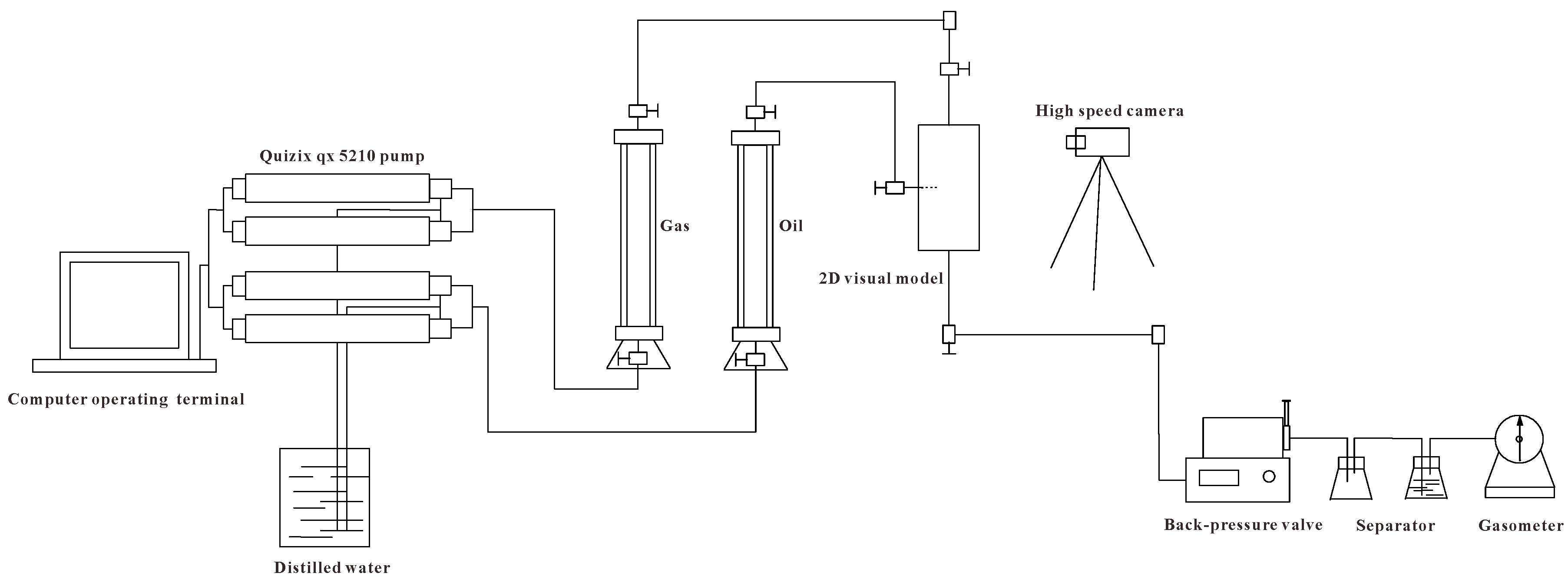
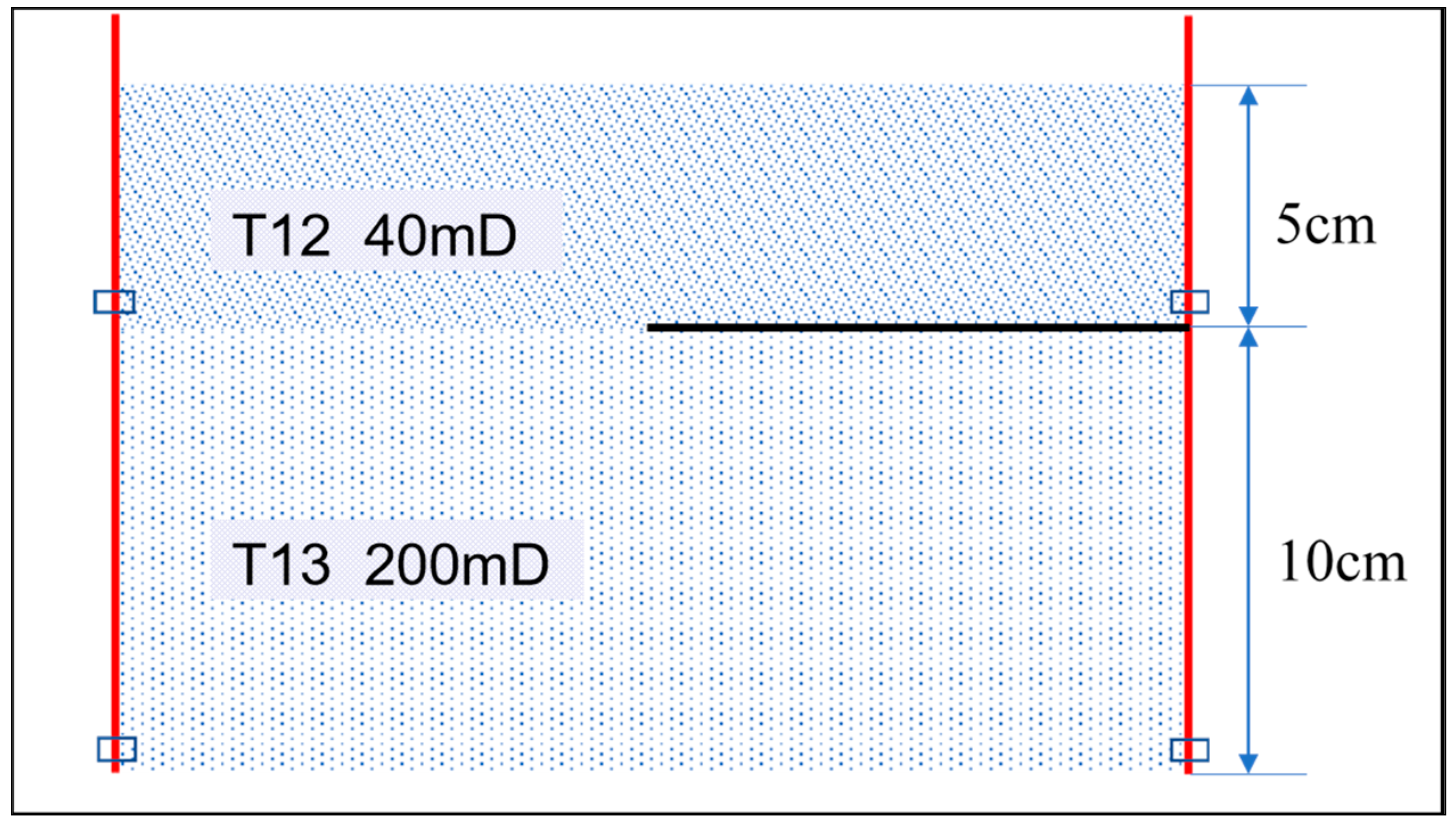


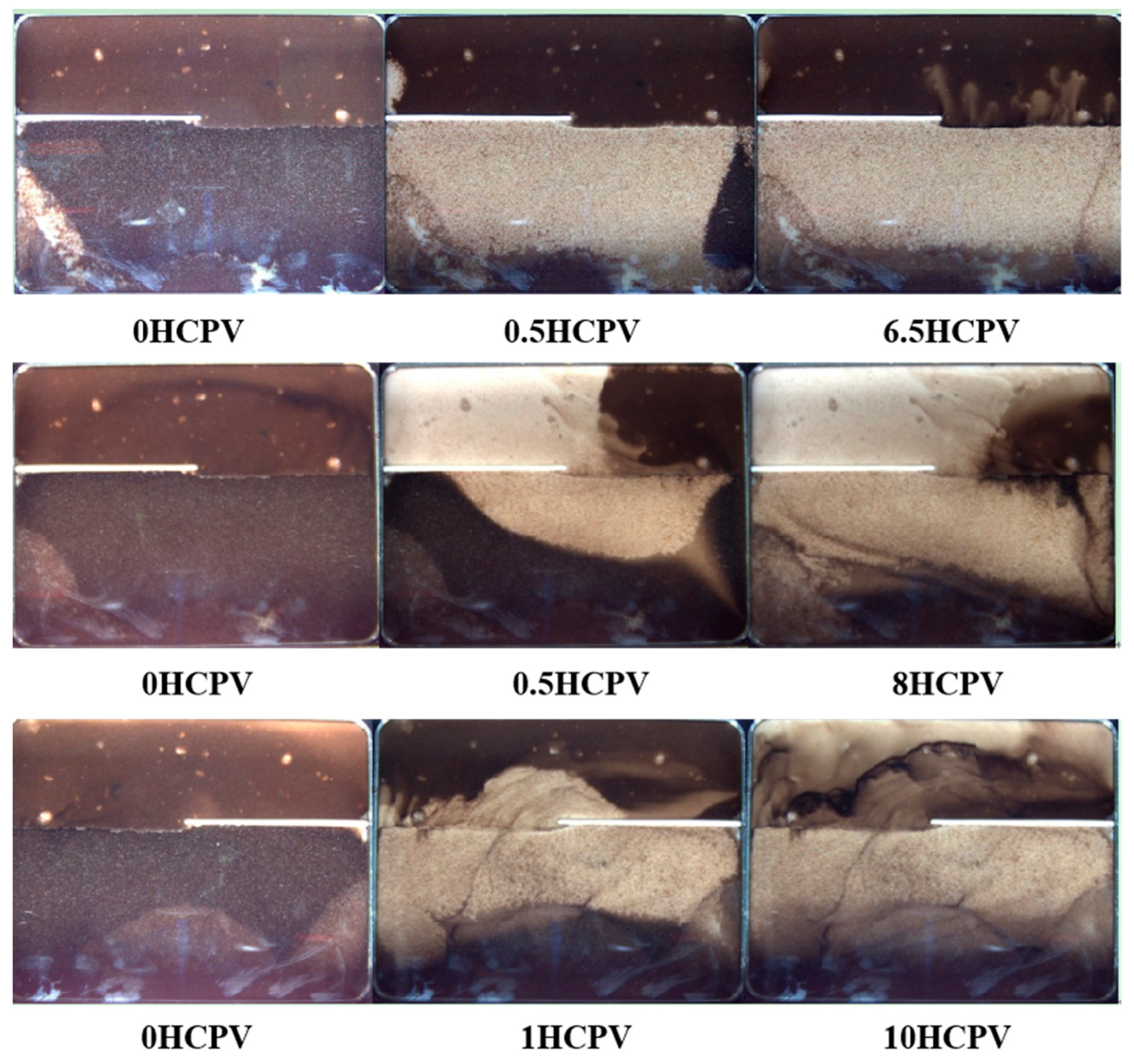

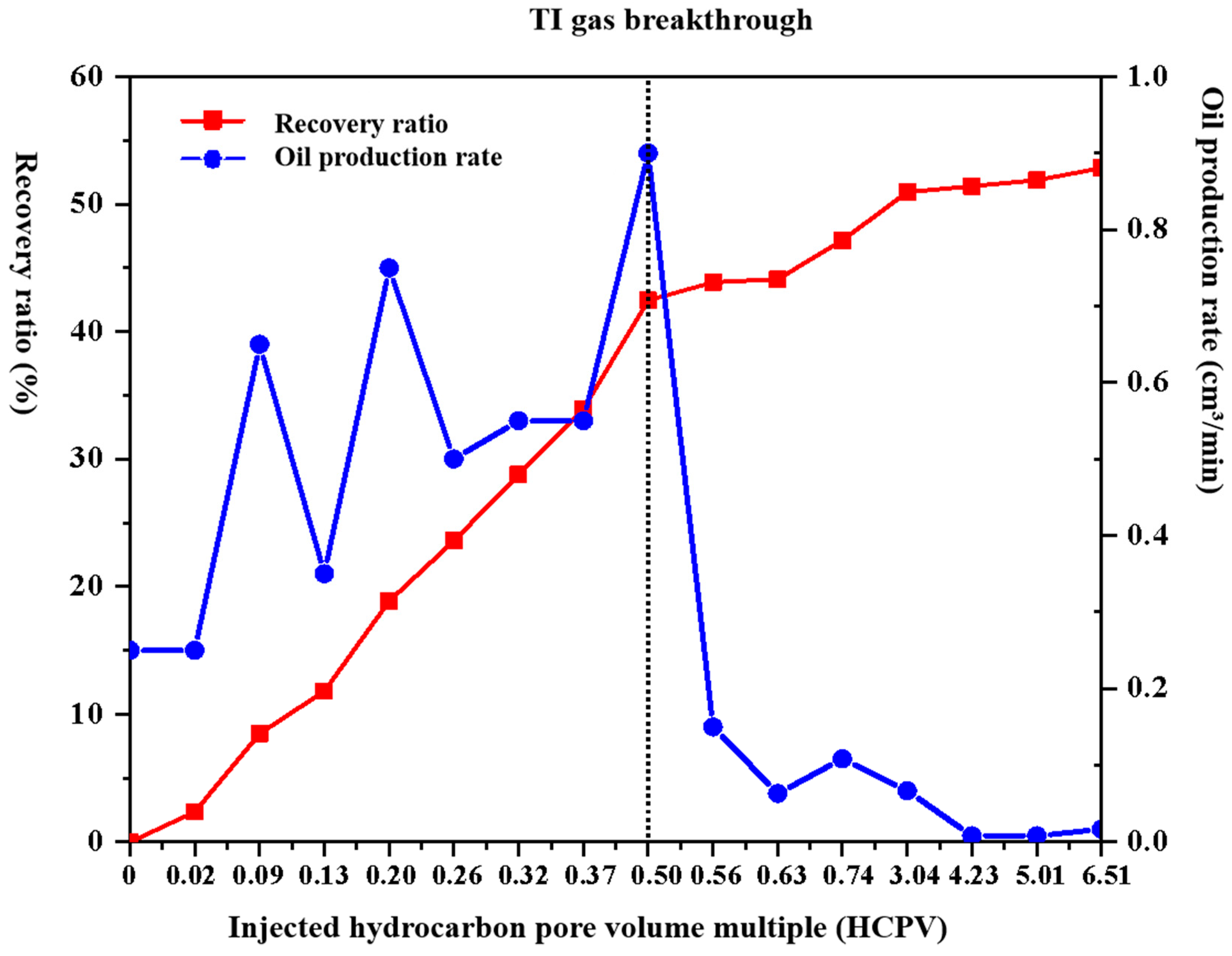
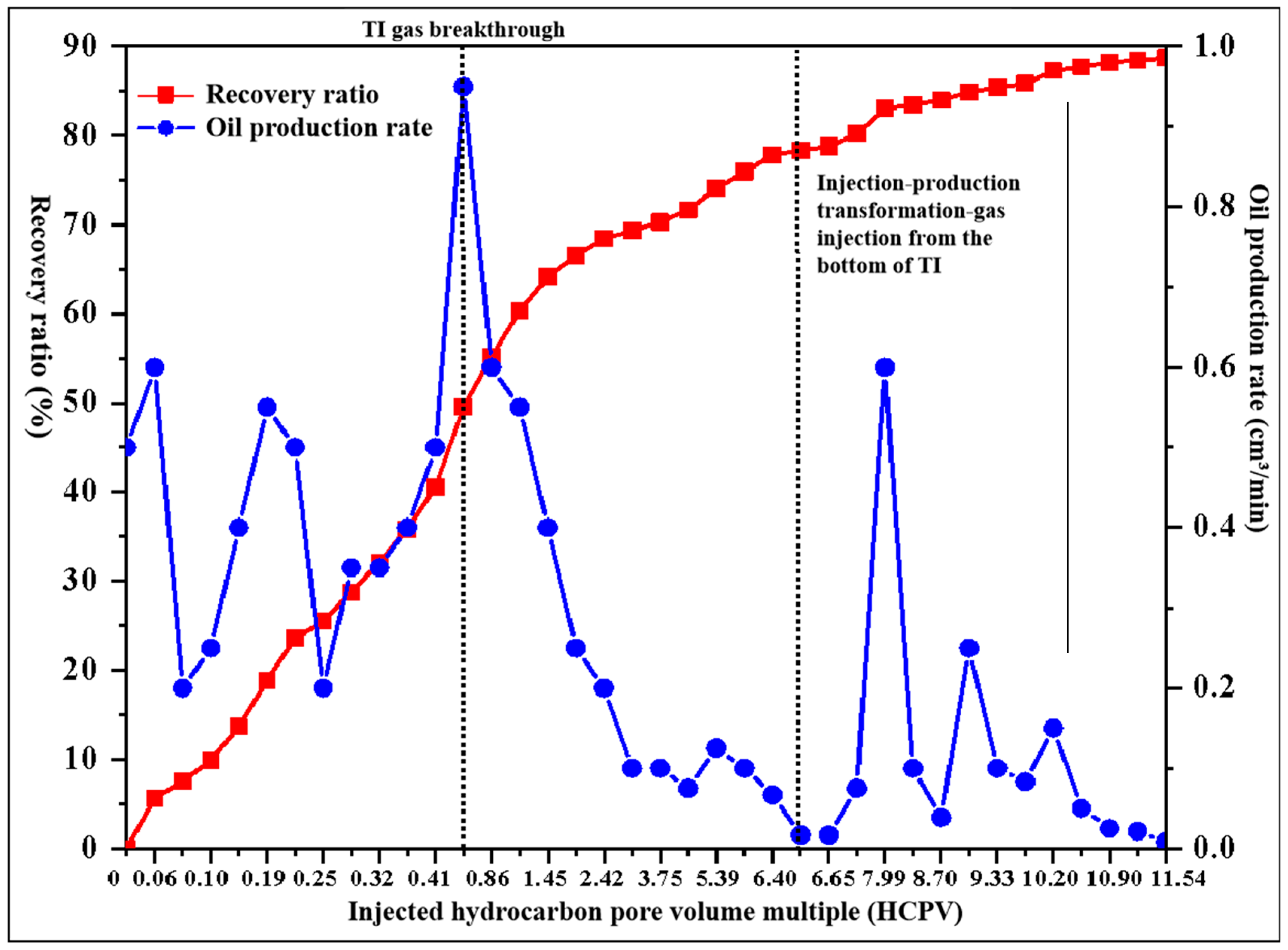
| Scheme Label | Injection Position | Production Position |
|---|---|---|
| 1 | T12, T13 co-injection, with compartmentalized interlayer at injection end (co-injection and co-extraction) | T12 and T13 combined mining |
| 2 | T12, T13 split injection, with the compartmentalized sandwich at the injection end (split injection and combined mining) | T12 and T13 combined mining |
| 3 | T12, T13 split injection, isolated interlayer at extraction end (combined injection and extraction) | T12 and T13 combined mining |
Disclaimer/Publisher’s Note: The statements, opinions and data contained in all publications are solely those of the individual author(s) and contributor(s) and not of MDPI and/or the editor(s). MDPI and/or the editor(s) disclaim responsibility for any injury to people or property resulting from any ideas, methods, instructions or products referred to in the content. |
© 2024 by the authors. Licensee MDPI, Basel, Switzerland. This article is an open access article distributed under the terms and conditions of the Creative Commons Attribution (CC BY) license (https://creativecommons.org/licenses/by/4.0/).
Share and Cite
Wang, R.; Zhou, W.; Tang, Y.; Zhou, D.; Wu, Z.; Lian, L. Microscopic Experiments to Assess the Macroscopic Sweep Characteristics of Carbon Dioxide Flooding. Appl. Sci. 2024, 14, 9007. https://doi.org/10.3390/app14199007
Wang R, Zhou W, Tang Y, Zhou D, Wu Z, Lian L. Microscopic Experiments to Assess the Macroscopic Sweep Characteristics of Carbon Dioxide Flooding. Applied Sciences. 2024; 14(19):9007. https://doi.org/10.3390/app14199007
Chicago/Turabian StyleWang, Rujun, Wei Zhou, Yongliang Tang, Daiyu Zhou, Zangyuan Wu, and Liming Lian. 2024. "Microscopic Experiments to Assess the Macroscopic Sweep Characteristics of Carbon Dioxide Flooding" Applied Sciences 14, no. 19: 9007. https://doi.org/10.3390/app14199007





